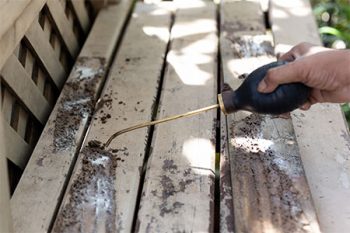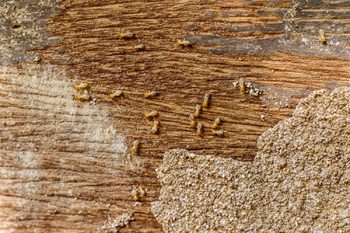Getting Rid of Termites
Termites in Arizona are an enormous problem. In the Phoenix metro area, the main species of termite that we deal with is known as the Hetrotermes.
Types of Termites


The Hetrotermites are a neighborhood problem. They always feed on multiple food supply sources: your house, the neighbor’s house, dead tree roots, woodpiles, whatever source they can find they actively pursue for nutrition. Subterranean termites consume the wood components that make up your house. The subterranean termites take the wood back down into their colony, they feed the reproductives, they feed the larva, and they interact socially.
How to know Termites are present
Termites live in cryptobiotic life, which is a hidden life. For every area where they have visibly manifested, the assumption can be made that there are many more areas they infest that you cannot see. This hidden lifestyle allows subterranean termites to enter structures and damage structures without you ever, even knowing. An analogy I commonly use is that termites are like a cancer of the house; they eat it from the inside out. The damage that they do can be significant. It is a fact that termites cause more annual damage than fires, storms, tornadoes, and hurricanes combined.
Termites can enter a home through cracks that exist around the foundation or in the flooring and around conduit that penetrates the slab. Once you have evidence or visible signs of termites, it is evidence that we call “presumptive of an underlying infestation.”
Termite removal
The treatment of subterranean termites in the Phoenix metropolitan area should always be done by a professional. The structure should be inspected, a detailed diagrammatic description should be made, and then a treatment plan can be properly prescribed.
The most effective treatment to control subterranean termites in the Phoenix metro areas is to do a conventional treatment. Anteater Exterminating uses Termidor SC® predominantly. This product is by far the most effective when treating for subterranean termites. If you are having your structure treated, you should consider using Termidor SC®.
How to remove Termites


Anteater Exterminating, Inc. may have to drill through attached porch slabs and inject the material underneath the slab to obtain 4 gallons per 10 linear feet. The drill holes are patched after treatment. It may also be necessary to drill through the garage slab and utilize the same process as on the concrete porch slabs.
Additionally, termites may enter a home through cracks that can exist where the interior floor slab meets the inside of the stem wall, along with where conduits penetrate the slabs or cracks that may have formed through the stress on the floors slab. All of these areas may need to be addressed if there are active termites found on the interior of your home.
Depending on the type of construction of your home, there may be a combination of various other treatments that would also need to be performed. For this reason, it is essential to have a visual inspection to determine the type of construction, to determine the extent of the infestation, and to plan the correct method of treatment.
A newer type of construction that is becoming common in Arizona is post-tension construction slabs. These slabs do not have any interior cracks through which the termites can transverse to gain access to your home. Post tension slabs can not be drilled because it would damage the slab and cause structural integrity defects. This would be one of many good reasons to have a professional inspect your home who is knowledgeable about construction and determine the type of specific treatment needed.
Recently, there have been newer products that have been introduced to the market that have given us other tools in our toolbox that we can use to combat subterranean termites. One of these materials is known as Termidor Dry®, and it has the advantage of the Termidor Transfer Effect®. It can be applied directly to termite areas of activity inside of different wood components that comprise your home.
Termite Control Near Me
Anteater Exterminating offers a 5-year guarantee with some of our termite treatments. This termite treatment guarantee is comprehensive and will offer you the highest degree of protection in the event that further termite problems are contracted.
1. Chemical Barrier Treatments: This involves applying liquid termiticides around the perimeter of your home or building. The goal is to create a barrier that termites cannot cross, effectively protecting the structure.
2. Baiting Systems: Termite baits are strategically placed around the property. Termites consume the bait and share it with the colony, eventually leading to its elimination. Baiting systems are less invasive and can be effective for long-term control.
3. Wood Treatments: For drywood termites, treating infested wood directly with termiticides or heat can eliminate colonies. This method is targeted and effective for localized infestations.
4. Fumigation: This is a highly effective method for severe infestations or widespread termite problems. It involves enclosing the structure and introducing a fumigant that penetrates all areas, killing termites throughout.
5. Integrated Pest Management (IPM): Combining several methods, including monitoring, habitat modification, and chemical treatments, to manage and prevent termite infestations.
Knowledge and Expertise: Pest control professionals are trained to identify termite species, assess the extent of the infestation, and apply appropriate treatments.
Equipment and Tools: Effective termite treatments often require specialized equipment and tools that professionals have access to.
Safety and Regulations: Handling termiticides and fumigants can be hazardous. Pest control professionals are trained in safety protocols and adhere to regulations for proper application.
Guaranteed Results: Professional pest control services typically come with warranties or guarantees, ensuring that if termites return within a certain period, they will retreat at no additional cost.
While DIY products may offer temporary relief, a termite infestation requires thorough and effective treatment to prevent damage to your home. Professional pest control services provide comprehensive solutions and peace of mind.
Structural Damage: Termites feed on wood, including support beams and other structural components. Over time, this can weaken the integrity of your home and lead to costly repairs.
Hidden Infestations: Termites can be difficult to detect because they often reside inside walls, floors, and other hidden areas. By the time you notice visible signs, such as mud tubes or damaged wood, the infestation may be extensive.
Financial Impact: Repairing termite damage can be expensive. Most homeowner’s insurance policies do not cover termite damage, so prevention and early detection are crucial.
Health Risks: While termites do not pose direct health risks to humans, the presence of termites and their byproducts can exacerbate allergies and respiratory issues in some individuals.
Given these factors, it’s advisable to schedule regular termite inspections and take preventive measures to protect your home from termites. Prompt action at the first sign of termites can help minimize damage and avoid costly repairs in the future.
